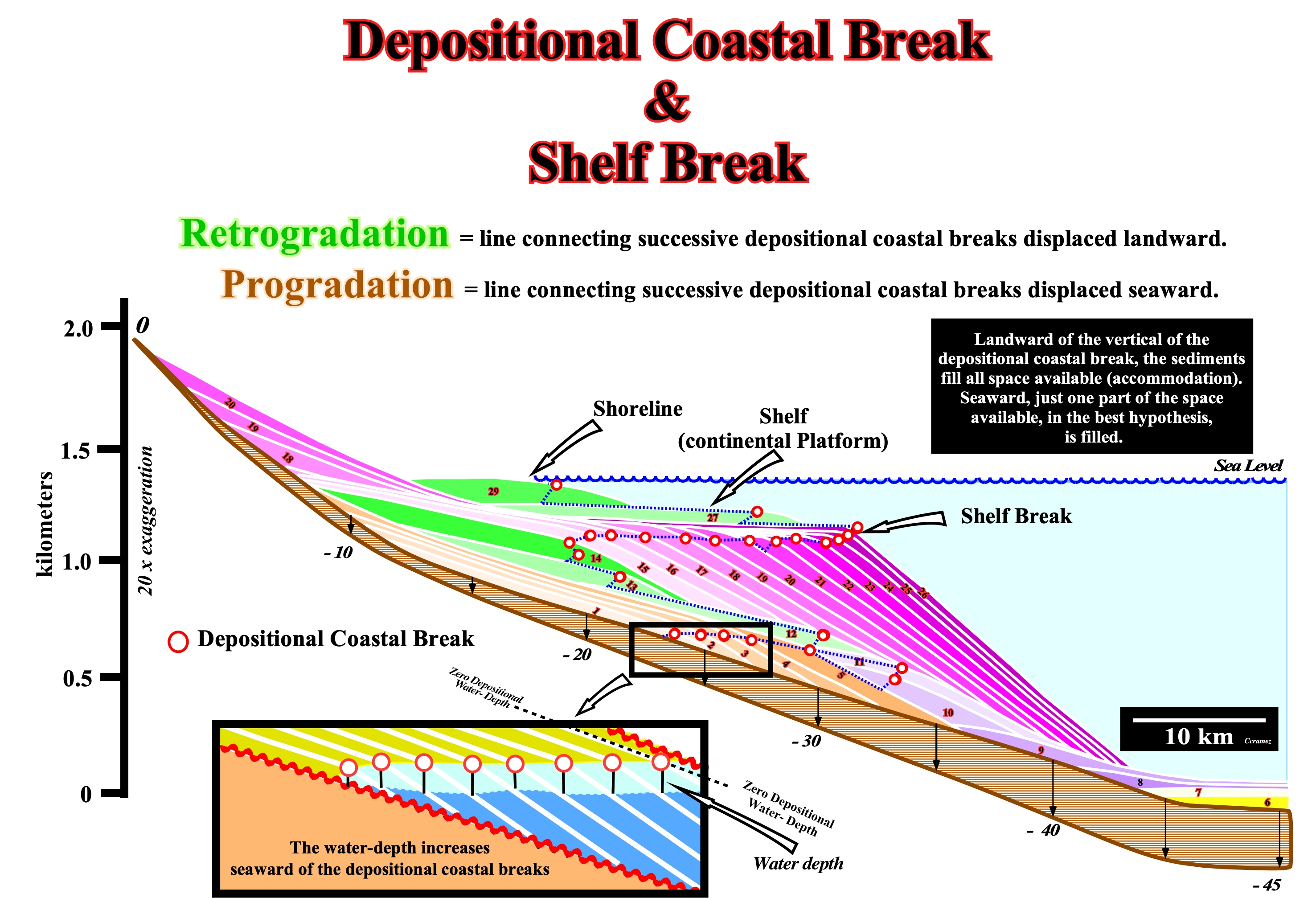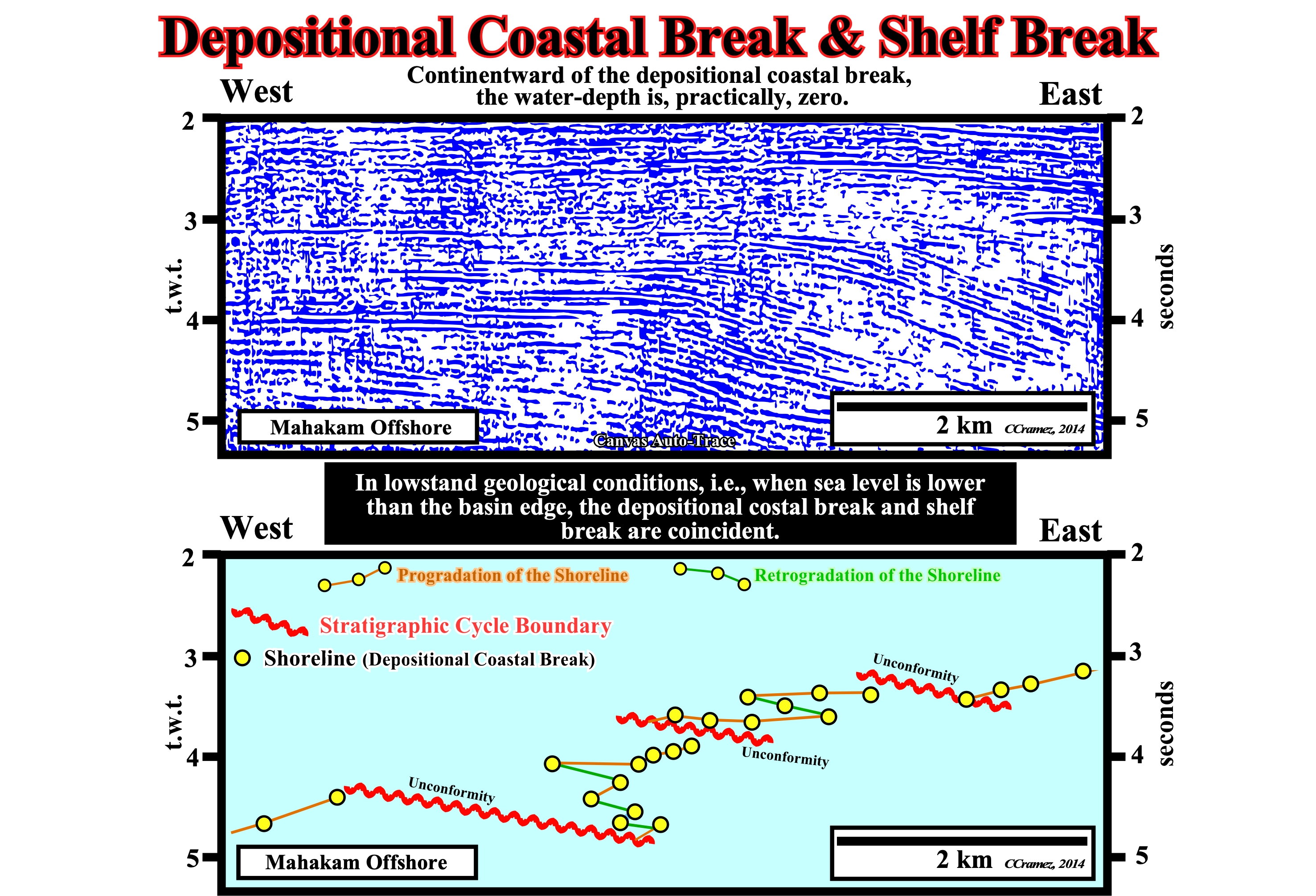

Depositional Coastal Break
Along a depositional surface, the coastal abrupt dip change or depositional coastal break corresponds to the lower erosion level of the waves when the sea is calm, i.e., about 10-20 meters below sea level (taking into account the seismic resolution, on a seismic line, the shoreline and the depositional coastal break are, generally, more or less coincident).
Function of the geological conditions, the depositional coastal break may correspond to the shelf break or to the continental break (boundary between the platform and the upper slope). In a sequence-cycle, during the 2nd phase of the highstand prograding wedge (HPW), the depositional coastal break and the shelf break are coincident, because the basin has no shelf. They correspond to what certain geoscientists call continental edge. During the transgressive interval (TI), the depositional coastal break migrate landward from the shelf break, creating or increasing the shelf (platform). The retrogradation of the coastal deposition break increases water-depth and the extension of the platform, creating at the same time, starved geological conditions in the distal area near the shelf break, which remains, more or less, in the same place.

Figure 078- On this geological model, within the sequence-cycles (just the middle sequence-cycle is complete), the displacement of depositional coastal break is, emphasized by the red dots. Relative sea level falls create seaward and downward shifts of the depositional coastal breaks, which emphasize the unconformities bounding the sequence-cycles. In this model, there are two displacements of the depositional coastal break : (i) Between the chronostratigraphic lines 5 and 6, and (ii) between the lines 21 and 22. A single sedimentary regression (seaward displacement of the shoreline and associated coastal deposits) or a single sedimentary transgression (landward displacement of the shoreline and associated coastal deposits) are, mainly, dependent of the terrigeneous influx. Assuming constant relative sea level rise increments, if the terrigeneous influx is important, there are global seaward displacements of the shoreline (progradational geometry). When the terrigeneous influx is weak, globally, the shoreline is displaced continentward (retrogradational geometry). As seaward of the shoreline (roughly the depositional coastal break on seismic lines, taking into account the seismic resolution), the depositional water-depth is zero, knowing the vertical scale in meters (and not in t.w.t.), it is possible to calculate the water-depth seaward of the depositional coastal break along the dipping sector of a chronotratigraphic line.
Landward of the depositional coastal break, all accommodation, i.e., all space available for the sediments, is filled. A relative sea level rise of 15 meters, for instance, increases the accommodation of 15 m. During the stability period of the relative sea level rise, 15 meters of sediments will be deposited updip of the previous position of the shoreline (position of depositional coastal break before the marine ingression).
Seaward of the depositional coastal break, the available space is, partially, filled or not filled at all. For relative sea level rise of 20 meters, Seaward of the coastal break, if just 5 meters of sediments were deposited, the total depth of water increases 15 meters. Seaward of the depositional coastal break, the accommodation is equal to the thickness of sediments deposited plus the water-depth. In fact, seaward of the shelf break, the accommodation is large enough to allow sedimentation without any relative sea level rise. Deposition can occurs even during relative sea level falls (e.g. or "exempli gratia" turbidites).

Figure 079- In this Kalimantan offshore seismic line (Indonesia), between 3 and 5 seconds (t.w.t.), the depositional coastal break and shelf break (or continental break) are, roughly, coincident taking into account the seismic resolution. This sedimentary interval is, globally, regressive. The depositional coastal break is not continuous. Three seaward and basinward displacements of the depositional coastal breaks induced by relative sea level falls are easily recognized. They characterize three unconformities, which are, mainly, induced by eustasy (absolute sea level changes) , since the coastal plain is, always, more or less, horizontal. Moreover, between each unconformity, the depositional coastal break displays progradational (in brown) and retrogradational (in green) displacements.
The recognition of the seaward and basinward displacements of the depositional coastal break or the shelf breaks (when the basin has no shelf), is an important step towards the unconformity identification. This is particularly true, on the tentative geological interpretations interpretations of the seismic lines. In fact, on the seismic lines, at the hierarchical level of sequence-cycles, landward of the shelf break and on the abyssal plain, the horizontal geometry of the reflectors is not favorable to a good and easy identification of the unconformities. In a practical manner, unconformities are, often, recognized near the shelf break by the seaward and basinward displacement of the coastal onlaps or by the presence of incised valley or submarine canyons, and then extrapolated landward or seaward.